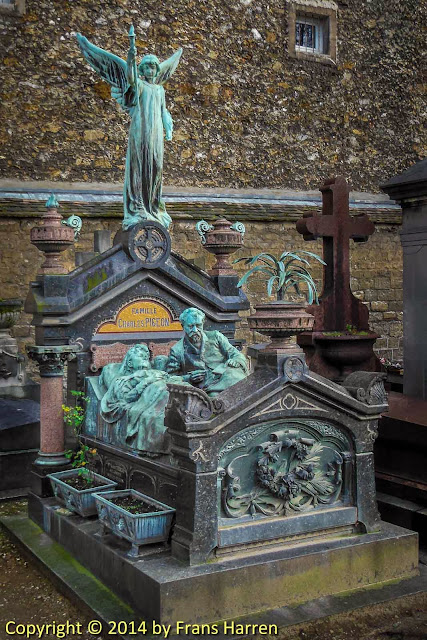
Charles Pigeon
Charles-Joseph Pigeon (29 March 1838 – 18 March 1915) was born in Le Mesnil-Lieubray in Normandy in France.
He started as a salesman in Le Bon Marché in Paris, where he became a close friend of Ernest Cognacq, subsequently the founder of the Samaritaine department store.
Pigeon became a dealer in cycle lamps and other lamps. His invention and manufacture of the Pigeon lamp, a non-exploding gasoline lamp, in 1884 (exhibited at the Exposition universelle de 1900), made him famous and wealthy.
After his death he remains noted for his family grave in Montparnasse Cemetery in Paris, which he commissioned in 1905 to hold up to 18 family members. The main feature is a life-sized bronze sculpture[1] of Pigeon (notebook and pencil in hand) and his wife lying on a bed, overlooked by an angel.
See: wikipedia
Montparnasse Cemetery
Cimetière du Montparnasse is a cemetery in the Montparnasse quarter of Paris, part of the city's 14th arrondissement.
History
Created from three farms in 1824, the cemetery at Montparnasse was originally known as Le Cimetière du Sud (Southern Cemetery). Cemeteries had been banned from Paris since the closure, owing to health concerns, of the Cimetière des Innocents in 1786. Several new cemeteries outside the precincts of the capital replaced all the internal Parisian ones in the early 19th century: Montmartre Cemetery in the north, Père Lachaise Cemetery in the east, and Montparnasse Cemetery in the south. At the heart of the city, and today sitting in the shadow of the Eiffel Tower, is Passy Cemetery.
Notes
Montparnasse Cemetery is the eternal home of many of France's intellectual and artistic elite as well as publishers and others who promoted the works of authors and artists. There are also monuments to police and firefighters killed in the line of duty in the city of Paris. There are also many graves of foreigners who have made France their home.
The cemetery is divided by Rue Émile Richard. The small section is usually referred to as the small cemetery (petit cimetière) and the large section as the big cemetery (grand cimetière).
Because of the many notable people buried there, it is a highly popular tourist attraction.
See: wikipedia











0 comments:
Post a Comment